Boiler in a heating system with natural circulation. Heating systems with natural circulation and features of their functioning
Heating system with natural circulation is good because it works regardless of the presence of electricity, which in some areas is very important. Another thing is that it is extremely difficult to obtain comfortable conditions under such a scheme, and in some cases it is impossible. Because often heating is made gravity (one of the names) to use this mode as an emergency, and the rest of the time the pump is running. But in some cases, for example, on non-electrified country plots, the heating system without a pump is the only possible option.
A system with natural circulation (EC) is sometimes called gravitational due to the fact that it works on the principle of gravity. Another name is gravity flow. All these terms denote one principle of construction - without the use of a pump.
Principle of operation of the EC system
The heat carrier in gravity systems moves due to the difference in the temperatures of the coolant and, correspondingly, their different density: from the boiler comes hot water, density and weight which is much lower than that of the cold one. Therefore hot water is forced out. Hence the main feature of such systems - the boiler should be located below the radiators. Further, the coolant moves along the pipe with a slight inclination. From the main highway, smaller diameter pipes lead to the radiators / registers.
Simpler such a system is realized in systems with the upper distribution of water - this is when the pipe from the boiler rises to the ceiling and from there already descends to the radiators. In systems with lower distribution, the gravitational system can be realized only in the presence of an accelerating circuit - an artificial difference in altitude is created: from the boiler, the pipe rises almost under the canopies, there, at the upper point, an expansion tank is installed. After it, the pipe descends to a level above the radiators, but not under the ceiling, but at the level of the windows. From there already there is a wiring for the radiators. With the device of the upper circuit, you can only be hindered by a low ceiling - preferably, from the top of the boiler the pipe should be higher than 1.5 meters (and also the tank).
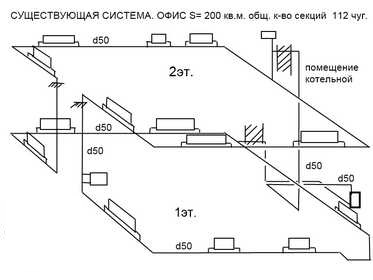
Types of heating systems with natural circulation
The heating of the EC in duplex and more houses can be realized both in single-tube and in.
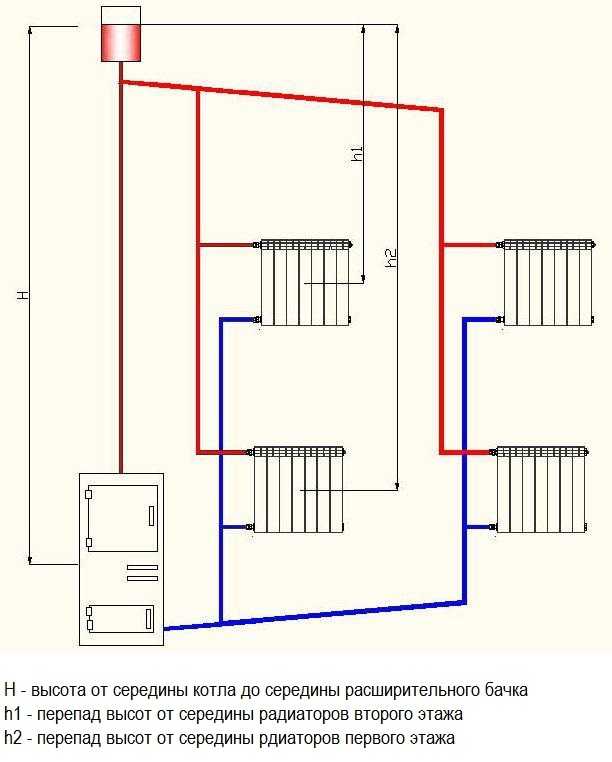
In this case, the principle is maintained - from the boiler, the pipe rises up to the maximum height, and only then is the distribution of the coolant along the heating elements. The only difference is that in a two-pipe system the cooled water is collected in another pipeline, and it is put into the boiler return duct. In the same pipe, this tube is fed by a pipe from the outlet of the last radiator.

A system with a natural circulation of a single-story house. Single-pipe scheme, wiring - top
All the above diagrams of single-tube spreaders - with vertical risers. They are more expensive in terms of the quantity of materials, but are convenient in that each riser can be connected with heating devices on each of the floors. In principle, in two-story house with a large area is more profitable to implement water heating with natural circulation with horizontal wiring. It may look something like this (see the diagram below).
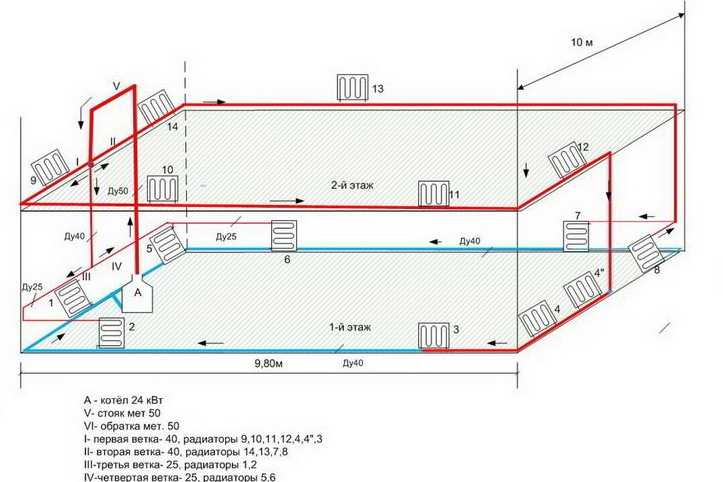
In this project, a heating scheme with natural circulation "Leningrad" has been implemented. For more active circulation on the second floor there is an accelerating collector, after which two circuits diverges on the second floor - horizontal serial connection radiators. Another contour descends to the first floor, where it also divides into two branches. Also in addition to the first floor are the risers from the last in the radiator circuit in each of the branches of the second floor.
Heating Radiators EC
For gravity systems, the main thing is the minimum resistance to water flow. Therefore, the wider the radiator clearance, the better the coolant will flow through it. Virtually ideal from this point of view - they have the smallest hydraulic resistance. Good to use and, but you need to look for their inside diameter to be at least 3/4 ". It is possible to use steel tubular batteries, unequivocally not recommended steel panel or any other with a small cross-section and high hydraulic resistance - through them or will not flow water or will be very weak, which, for example, with a single-pipe system can lead to a lack of circulation at all.

Systems with natural circulation (click on the picture to zoom in)
There are in the connection of radiators their subtleties. Particularly important is the installation method in the single-pipe system: only with the help of of different types connection can achieve better performance of heating elements.

The figure below shows the radiator connections. The first is an unregulated serial connection. With this method, all the shortcomings of the "Leningrad" will appear: different heat dissipation of radiators without the possibility of compensation (regulation). A little better is the situation if you put a regular jumper from the pipe. With this scheme, there is also no possibility of regulation, but when the radiator is activated, the system functions, because the coolant passes through the bypass (jumper). Having installed two ball valves additionally behind the jumper (there is no in the figure), we are able to remove / disconnect the radiator with the flow shut off without stopping the system.
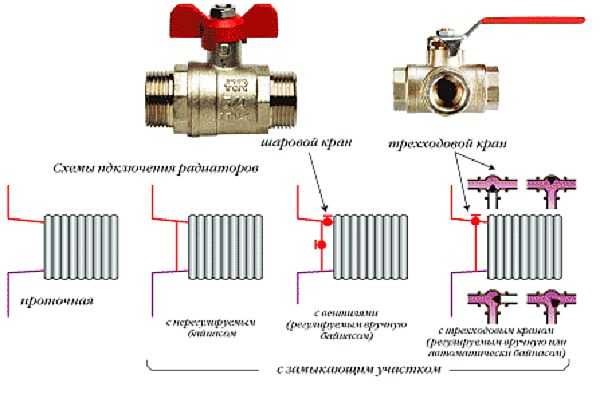
The last two ways of installation allow to regulate the flow of coolant through the radiator and bypass - they stand. With this switch-on, the circuit can already be compensated (heat emission is set on each heater).
Equally important is the type of connection: side, diagonal or bottom. By operating these connections it is possible to facilitate / improve the payment of the system.
Pipes for systems with natural circulation
When choosing the diameter of the pipes, not only the dimensions of the system and the number of radiators play a role, but also the material from which they are made, or rather, the smoothness of the walls. For gravitational systems this is a very important parameter. The worst situation is with conventional metal pipes: the internal surface is rough, and after use it becomes even more uneven due to corrosion processes and accumulated deposits on the walls. Because such pipes take the largest diameter.

Preferred from this point of view and reinforced polypropylene. But in metal-plastic, fittings are used, which significantly tighten the lumen, which can become critical for gravity systems. Therefore, reinforced polypropylene looks more preferable. But they have limitations on the temperature of the coolant: the operating temperature is 70 ° C, the peak temperature is 95 ° C. In products made of special PPS plastic, the operating temperature is 95 ° C, the peak temperature is up to 110 ° C. So depending on the boiler and the system as a whole Use these pipes, with the proviso that this is a quality branded product, not a fake.
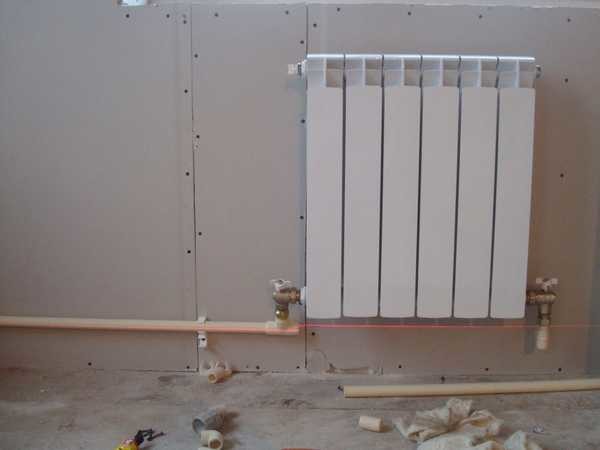
But if the installation is supposed, no polypropylene of such thermal loads will survive. In this case, or still use steel, or galvanizing and stainless steel on threaded joints (welding during the installation of stainless steel is not used, because the seams very quickly flow). Suitable and copper (o), but it also has its own characteristics and must be handled with care: not with all the coolants it will behave normally, and with aluminum radiators it is better not to use it in one system (they are quickly destroyed).
The peculiarity of systems with natural circulation - they can not be calculated because of the formation of turbulent flows, which can not be calculated. Design them based on experience and averaged, empirically derived norms and rules. In general, the following rules apply:
- to raise as much as possible the point of dispersal;
- do not narrow the feed pipes;
- put a sufficient number of radiator sections.
Then they apply one more thing: from the place of the first branching and each subsequent lead by a pipe of smaller diameter. For example, a 2-inch pipe comes from the boiler, then from the first branch, 1 ¾, then 1 ½, etc. The collection is collected from a smaller diameter to a larger one.
There are several more features of installing gravity systems. The first - it is desirable to make pipes under a slope of 1-5%, depending on the length of the pipeline. In principle, with sufficient temperature and altitude difference, horizontal layout can be made, the main thing is that there are no areas with a negative bias (inclined in reverse side), which, due to the formation of air plugs in them, will block the flow of water.

The second feature - at the highest point of the system you need to install an expansion tank and / or. Expansion tank can be open type (the system will also be open) or membrane (closed). When installing an open air vent, there is no need to collect it at the highest point - in the tank and vent into the atmosphere. When installing a membrane-type tank, an automatic air vent is also required. With horizontal wiring, the "Mayevsky" cranes on each of the radiators will not interfere - with their help it is easier to remove all the air plugs in the branch.
Boiler for gravity systems
Since basically such circuits are necessary for the device of electricity-independent heating, the boilers must also operate without using electricity. It can be any non-automated units, except pellet and electric.
Most often in systems with natural circulation work. They are all good, but in many models the fuel burns quickly. And if there are severe frost outside the window, and the house is not sufficiently insulated, then at night it is necessary to get up and take in the fuel at an acceptable temperature. Especially such a situation is often found where it is heated with firewood. Exit - buy (non-volatile, of course). For example, in Lithuanian solid fuel boilers Stropuva, under certain conditions, firewood burns up to 30 hours, and coal (anthracite) up to several days. On the boilers of Candle claimed slightly worse characteristics: the minimum burning time of firewood 7 hours, coal - 34 hours. There are boilers without automation and pumps and the German campaign Buderus, Czech Viadrus and Polish-Ukrainian Wikchlach, as well as Russian producers: "Energy", "Ogonyok."

There are, which produce in Rostov-on-Don. They can be used in systems with natural circulation. The same factory produces non-volatile universal boilers "Don", which are also suitable for operation without electricity. They work in systems with natural circulation and some other assemblies of European and Asian manufacturers.
The second way, which will help increase the time between the furnaces, is to increase the inertia of the system. For this, heat accumulators (TA) are installed. They work well with solid fuel boilers, which do not have the ability to regulate the intensity of combustion: the excess heat is diverted to a heat accumulator in which energy is stored and consumed as the coolant cools down in the main system. The connection of such a device has its own peculiarities: it needs to be placed on the supply pipeline at the bottom. And for effective heat removal and normal operation - as close to the boiler as possible. However, for gravitational systems this decision is far from the best. They slowly enough reach the normal circulation mode, but they are self-regulating: the colder in the room, the cooler the coolant cools, passing through the radiators. The greater the difference in temperature, the greater the density difference and the faster the coolant moves. And the installed TA makes the heating more inertial, and the time and fuel for overclocking is much more. True, heat is given longer. In general, it's up to you.
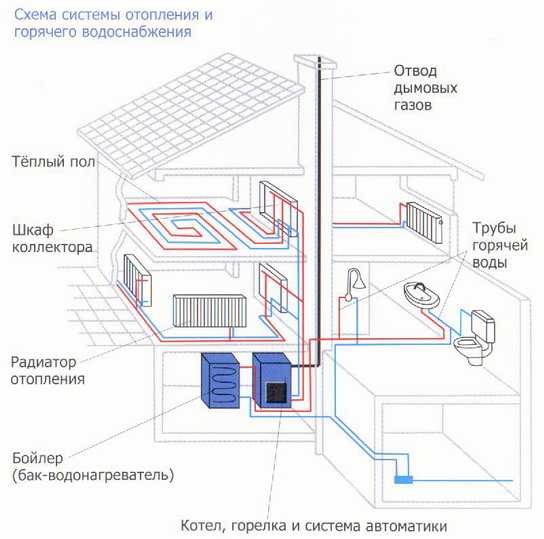
Approximately the same problems for furnace heating with natural circulation. Here the role of the heat accumulator is played by the furnace itself and also requires a lot of energy (fuel) to accelerate the system. But in the case of TA, it is usually possible to exclude it, and in the case of an oven this is unrealistic.
Heat carrier for systems with natural circulation
The best coolant for such systems is water. The use of antifreezes is possible, but in planning it is necessary to take this moment into account and increase the area of the radiators - or choose their larger size, or increase the number of sections. The thing is that these compounds have less heat transfer, because of what is worse, they take away and transfer heat, which often leads to overheating of both the boiler and the coolant.
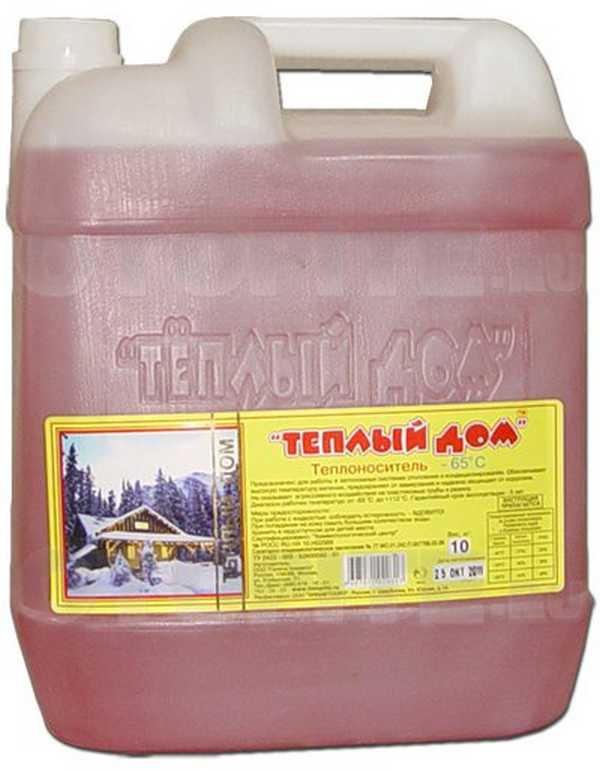
An increase in the temperature of the antifreeze liquid above the working fluid is a very unpleasant phenomenon, as the abundant formation of sediments and deposits begins. During two months of operation of the antifreeze with constant overheating, the heat exchanger of the boiler is clogged tightly, the system is almost overgrown. So if you plan to use a non-freezing liquid, make sure that it can give off heat and not overheat.
It should be taken into account that only specialized compositions can be used in heating systems. General-purpose or automotive are completely unsuitable, especially for open-circuit designs that contact the atmosphere. When planning to use antifreezes, when selecting materials, pay attention to their compatibility with non-freezing liquids. Not all boilers and pipes are "friendly" with them. The possibility of using non-freezing liquids is usually reported in passport data, if there is no such record, you need to clarify with the seller, or better with the manufacturer.
Conclusion
A system with natural circulation is not the best heating method, but sometimes the only possible method is in areas where there is no electricity supply. In the same regions where there is electricity, in case of interruptions, the scheme can be created as gravity flow, but to integrate the pump for regular operation. The truth and this solution is not the best: the volume of the system increases, it becomes more inertial and requires a large expenditure on heating the coolant. If interruptions are an exception to the rules, you can secure yourself by installing a backup power supply (or generator). If faults occur frequently - then your exit is systems with natural circulation.
One of the simplest is a heating system with natural circulation. However, this simplicity, in the absence of proper experience with such systems, can "come out sideways" in the process of exploitation.
Heating with natural circulation was widespread a dozen years ago in countryside small houses and some apartments with individual heating. Now the market is "conquering" systems with forced circulation coolant, thanks to the opportunities that they provide.
But let's talk about water heating with natural circulation.
Structural features of the system
Heating systems with natural circulation include:
- a heating boiler that heats water;
- supply pipeline, supplying hot water to radiators (radiators);
- return line, by which water is returned to the boiler;
- heating devices - radiators that give heat to the environment;
- , designed to compensate for the temperature expansion of the liquid.
Principle of operation of the system
The water, heated in the boiler, rises up the central riser and enters the radiators (heating appliances) along the supply line, where it gives away some of its heat. Further, already cooled water on the return line again enters the boiler and heats up again. Then the cycle repeats, providing a comfortable temperature in the heated room.
To ensure the natural circulation of the heat carrier (usually water) in the system, the horizontal parts of the pipeline are installed with a slope of at least 1 cm per running meter of the length of the horizontal section of the heating system.
Hot water, due to a decrease in its density when heated, rises up the central riser, squeezed out cold water, returning to the boiler. Then flows by gravity through the supply line to the radiators. After the "stay" in them, the water also flows gravitatively back into the boiler, again squeezing out the water already heated in the boiler.
The air that has fallen into the system with the coolant can create an air plug in the radiators, but, often, in such heating systems with natural circulation, air bubbles "travel" upwards through the slopes of the pipeline and exit into an open expansion tank (a tank in contact with atmospheric air ).
The expansion tank is designed to maintain a constant pressure in the heating system, due to the fact that it is filled with the increased volume of heat carrier when heated, which then "returns" back to the system as the temperature of the liquid decreases.
We draw conclusions!
So! The water in the system (riser to the supply pipe) is lifted thanks to the difference between the densities of the heated and cooled liquid. The movement (circulation) is also maintained thanks to gravitational pressure (the return pipe).
When the coolant moves through a pipeline in a heating system with natural circulation, the resistance forces act on the liquid:
- friction of the liquid against the walls of the pipes (to reduce the use of large diameter pipes);
- change the direction of motion of the liquid on bends, branches, channels of radiators (radiators).
Basic physical parameters of the heating system with natural circulation
The circulating head Pc is the physical quantity determined by the difference in the heights of the center of the boiler and the lowest radiator (radiator).
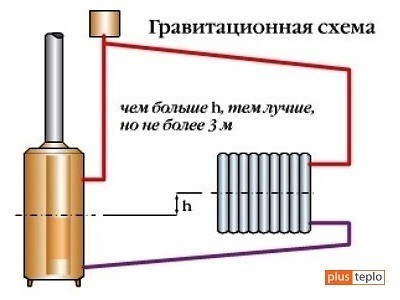
The greater the height difference (h) and the difference in densities of the heated (ρ g) and cooled (ρ о) liquids in the system, the more qualitative and stable the circulation of the coolant will be.
Р ц = h (ρ о -ρ r) = m (kg / m 3 -kg / m 3) = kg / m 2 = mm.water.st.
"Let's look" for the cause of the circulation pressure in the heating system with natural circulation in the "jungle" of the laws of physics.
Assuming that the temperature of the heating medium in the heating system "makes a leap" between the centers of the devices (boiler and radiators), that is, the upper part of the system contains more hot water than the lower part of the system.
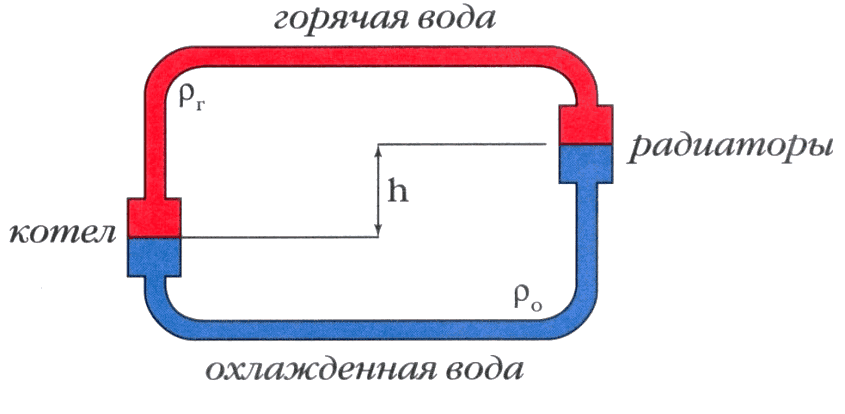
The density (ρ r) (ρ r).
We cut (mentally) the upper part of the outline and ... What do we see? A familiar picture from the school - two communicating vessels, located at different levels. And this will lead to the fact that the liquid from a higher point by the action of the gravitational force will flow into the lower one.
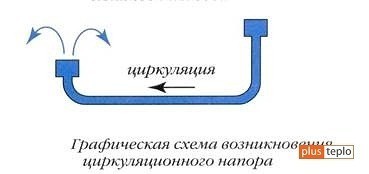
Due to the fact that the heating system is a closed circuit, the water does not splash out, but simply tends to level its level, which leads to pushing the heated water up and further to its "independent gravitational" path through the heating system.
The conclusion is this! The basic indicator of the circulation head is the difference in the heights of the installation of the boiler and the last (lower) in the radiator system. Therefore, in heating systems of private houses, boilers are located in basements where possible, observing a maximum height of 3 m.
In the apartment versions, the boilers try to "deepen" to the slab of the ceiling, correspondingly "fireproofing" the "nest" of the boiler landing in the floor.
According to the formula given above, the difference in density of cold and hot water in the system exerts a significant influence on the circulation head.
The heating system with natural circulation is a self-regulating system, that is, for example, when the heating water heating temperature is increased in a natural way (see the formula), the circulation head and, accordingly, the water flow increase.
At a low temperature in a heated room, the difference in water densities is large and the circulation head is large enough. When the room is warmed, the coolant no longer so cools in the radiators, and the difference in the densities of the heated and cooled coolant decreases. Accordingly, the circulation head decreases, reducing the "consumption" of water.
Cooled air in the room? For example, someone opened the door to the street. The density difference again increased, increasing the pressure of water.
Disadvantages and advantages of heating systems with natural circulation
The disadvantages of natural circulation include:
- A small circulation pressure, which determines the limited use of such heating systems - a small horizontal range (up to 30 m).
- Large inertia of the heating system, due to the large volume of the coolant in the system and low circulation pressure.
- The probability of freezing water in, which is usually in a cold (unheated) attic room.
The main advantage of such systems is the energy independence of solid fuel boilers. That is, such systems can be used in homes where there is no electricity. A large inertia of the system due to a sufficiently large volume of the coolant in the system can play both positive (a kind of a thermal battery with an "extinct" boiler) and a negative role - a considerable time of temperature change of the system, especially at the launch stage.
Types of heating circuits with natural circulation
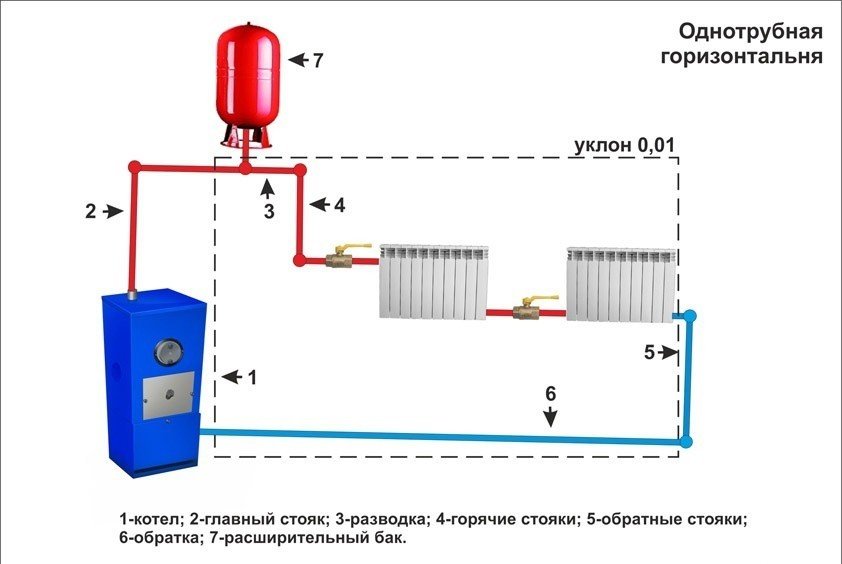
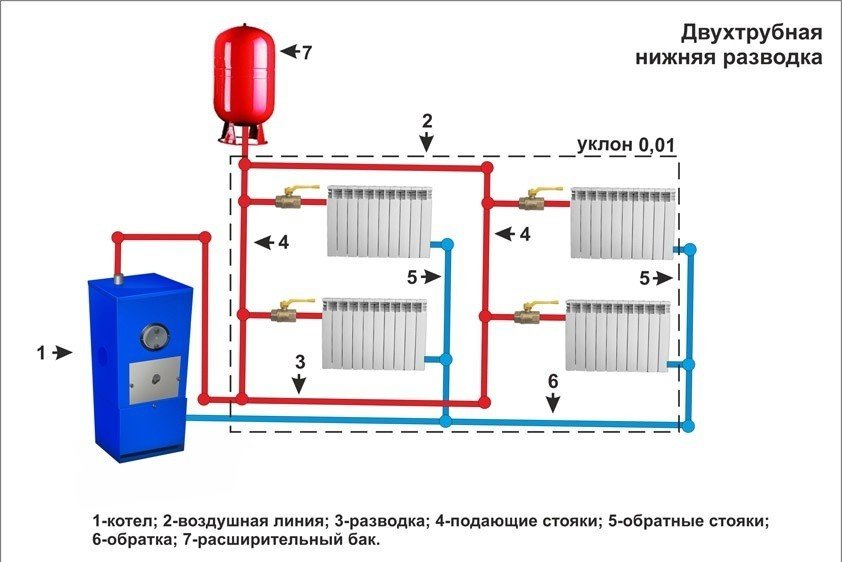
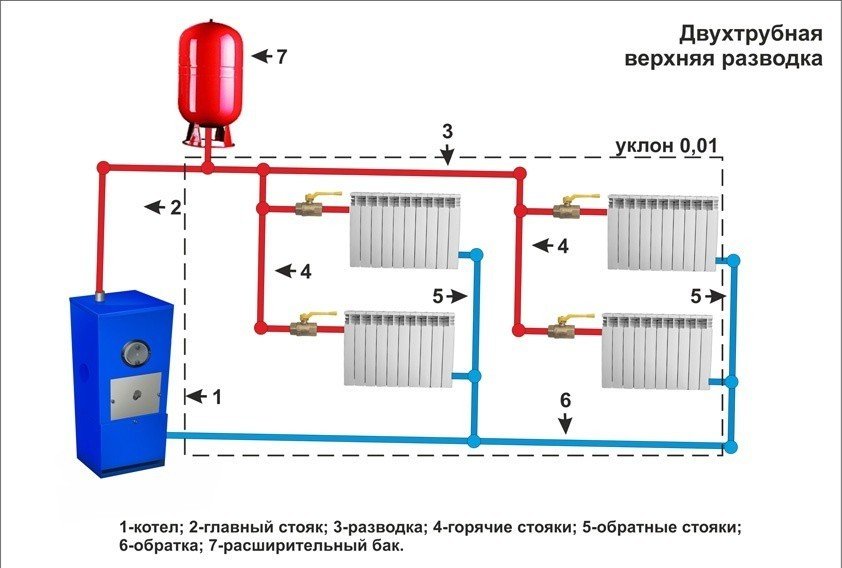
Which heating system with natural coolant circulation do you choose? We hope correct!
Video: heating medium circulation in the heating system
The heating system with natural circulation is today considered to be the simplest and most popular among owners of apartments and one-storey private houses. An obvious advantage is the long service life: with proper operation, the durability reaches 40 years without the need for repair. In addition, it is possible to install it yourself, using existing schemes.
Which fuel is more convenient?
In the event that gas is used as fuel, the heating with natural circulation is based on the principle of taking air from the room to the open burner and diverting the combustion product to the ventilation ducts. In this case, the boiler will need a room of 4m2 with good ventilation (windows and doors).
Therefore, such a scheme is not very convenient. Closed or open system water heating with natural circulation, which can be carried out by hand.
In multi-storey houses, a single-pipe system is often used. In general, the scheme with closing areas is used, when a part of the water comes up from the riser, part - downwards, thanks to the closing section, which ensures a balance of temperatures between the lower and upper floors. The system operates due to the difference in diameter of the connection pipes and the pipe of the closing section (by a smaller size). The two-pipe system, in comparison with the one-pipe system, is less compact and convenient to install.
disadvantages
First, the reduced radius: it is no more than 30 m relative to the horizontal. The drawback is caused by factors such as low circulation pressure and slow start. The latter is due to the high thermal capacity of the liquid and the reduced pressure forces. The second drawback is the probability of freezing water in the expansion tank.
Heating systems with natural circulation are not suitable for areas of more than 100 m2: not all of the space will be warmed up properly. Therefore, most often it is used for a small one-story house, villa.
Action Scheme
The structure of the water heating system includes a boiler (water heater), pipelines of the return and supply type, as well as heating equipment, and a safety valve. The liquid warms up to the desired temperature in the boiler and rises in the supply pipe and risers, thanks to the expansion.

From there, it goes into heating equipment - batteries and radiators, which gives part of the heat. Then the return pipeline directs water to the boiler, where it is again heated to the set temperature. The cycle repeats while the system is in working order.
It is important to remember that the horizontal pipes are mounted with a slope with respect to the movement of the working medium.
Protective mechanisms
The slope of the pipes allows the air to be diverted from the system towards the expansion tank: it enters the atmosphere without stopping in the pipes and not interfering with the movement of water.
The work of protective mechanisms is important. Thus, the inverse gravity valve avoids the circulation of water flow in the wrong direction, which is very necessary for two-pipe and one-pipe systems with top wiring at several contours.
Using the tank
Performs a number of important functions. First, it creates a constant pressure necessary for the normal operation of the entire system. Secondly, it assumes the volume of water that increases after heating. Third, it returns the cooled liquid to the pipeline.
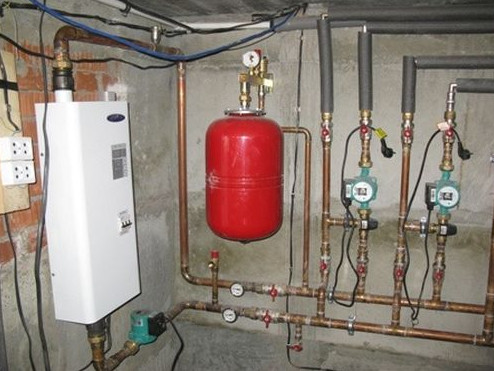
Processes in pipelines
Processes in pipes in natural circulation are associated with the movement of water. Thus, the rise of the liquid occurs through expansion due to heating and gravitational pressure. Gravitational pressure is needed to overcome friction with water by a pipeline that hinders its movement. The water starts to circulate due to the different density of cold and hot water: it moves up the feeder and down the back riser.
The magnitude of the gravitational pressure directly depends on the arising resistances. The more they appear on the coolant path, the higher the figure should be. It is also necessary to take measures to reduce the resistance to a minimum. Thus, friction can be reduced by using pipes with a large diameter.
From the laws of physics
Suppose, in radiators and a boiler, the temperature of a liquid changes in jumps along the central axes: the upper parts contain a hot liquid, and in the lower ones there is a cold one.
Hot water is less dense, which reduces its weight in comparison with cold. As a result, the heating system consists of two communicating vessels closed to each other, in which liquid moves from top to bottom.
![]()
A high column formed by the cooled water with a large weight, upon reaching the radiators, pushes the post low. As a result, the hot fluid is pushed and circulation occurs.
Indicators of pressure
To create a circulation pressure, the radiator centers are placed above the central part of the boiler. It is this height that is considered the main factor in the pressure head of circulation. The slope of the pipes and the "return flow" also affect this process: thanks to them, water better overcomes local resistance.
Increase in temperature
Another factor is the difference between the density of cold and hot water. Note the following fact: heating with natural circulation refers to a self-regulating type. Thus, if the water heating temperature is increased, its flow rate changes and the circulation head becomes higher.
Strong heating of the liquid in no small degree contributes to faster circulation. But this happens only in a cold room: when the air temperature in them reaches a certain mark, the batteries will cool down much more slowly.
Density, as heated in the boiler, and already caught in the radiators of water almost equal. The head will decrease, the rapid circulation of water will be replaced by a measured circulation inside the system.
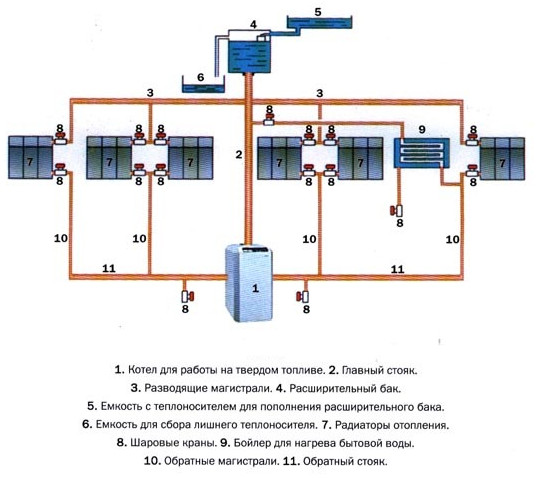
As soon as the temperature of the premises of a private house drops back to a certain level, it will serve as a signal to increase the pressure. The system will try to equalize the temperature conditions. To do this, you have to restart the process of rapid circulation. Hence the ability to self-regulation.
Briefly, the rule is the following: a one-stage change in temperature and volume of water allows you to get the desired heat output from batteries for space heating.
As a result, comfortable temperature conditions are maintained.
Where to put the boiler?
In a private house, in a one-story house heating boilers it is best to install below the level of appliances for heating the rooms. In the apartments the situation is somewhat different. Here boilers are often placed on a par with radiators, which is not quite effective. Therefore, the installation is better to produce as if in a pit, that is, put the equipment on the overlapping plates.

To do this, floor is usually cut out around the boiler. "Pit" should be done, observing the rules of fire safety. They assume the leveling of the base with a thin screed and the laying of sheets made of iron and asbestos. The boiler in the "pit" catches up the best circulation head.
Pipe Selection
The cross-section of the pipes is one of the decisive factors for circulation: the diameter of the pipes should not be as large as possible, but should not interfere with the flow of water. As a rule, 100 W / m2 is needed to heat a private house. Then for heating 25 m2 2500 W are required, i.e. 2.5 kW. The specified diameter of the pipe corresponds to its own thermal load. Three main categories:
- diameter ½ in. - thermal equivalent of 5.5 kW;
- diameter ¾ in. - thermal equivalent of 14.6 kW;
- diameter 1 inch - thermal equivalent of 29.3 kW.
In this case, to heat a single-storey house of 25 m2, you need to use the smallest ½-inch diameter pipes. The materials from which pipes are made can be different: high-quality steel, polypropylene pipes are also popular.
Modern homeowners often choose heating systems that function through natural circulation. Modern pumps are expensive, and gravity is a cheap driving force, because of which there is a natural circulation of water in the heating system and water moves through the pipeline. Gravity circuits are used where there is no electricity to power the pump. Sometimes the pump is still present, but in the event of an emergency situation and switching off under the influence of gravity. That is, even when the electrical equipment does not work, the heating with natural circulation continues to function.
This variant of the heating system is perfect for cottages, the area of which does not exceed 100 sq.m.Minus the design - the inability to use it in rooms with large squares. But for cottages with an area of less than a hundred square meters. m, this option is great. For this reason, many homeowners decide to make heating with natural circulation without outside help.
Principle of operation of a gravity heating system
The principle of operation of heating looks simple: water moves through the pipeline, driven by hydrostatic pressure, which appeared due to the different mass of heated and cooled water. Another such design is called gravity flow or gravity. Circulation is the movement of the liquid cooled in the batteries and the heavy liquid under the weight of its own mass down to the heating element, and the displacement of the lightly heated water into the supply pipe. The system functions when the boiler with natural circulation is located below the radiators.
A natural circulation is also possible in closed system heating, if equipped expansion tank with a membrane. Sometimes open-type constructions are converted into closed ones. Closed circuits are more stable in operation, the coolant in them does not evaporate, but they are also independent of electricity.
What influences the circulation head
The circulation of water in the boiler depends on the difference in the density of the hot and cold liquid and the difference in height between the boiler and the lowest located radiator. These parameters are calculated before the outline. Natural circulation arises, because the return temperature in the heating system is low. The coolant manages to cool down, moving through the radiators, becomes heavier and massively pushes out the heated liquid from the boiler, forcing it to move along the pipes.
Circulation scheme of water in the boilerThe height of the battery level above the boiler increases the head, helping water to overcome the resistance of the pipes more easily. The higher the radiators are in relation to the boiler, the higher the height of the chilled return column and with the greater pressure it pushes the heated water up when it reaches the boiler.
Density also regulates the head: the more heated the water, the less its density becomes in comparison with the return. As a result, it is pushed out with more force and the head increases. For this reason, gravity heating structures are considered to be self-regulating, because if the temperature of the water heating is changed, the pressure on the coolant will change, and, therefore, its consumption will change.
During installation, the boiler should be positioned at the very bottom, below all other elements, in order to ensure sufficient pressure of the coolant.
Scheme of installation of gravity heating systems
Since the circulation of water in the heating system takes place without the participation of the pump, for unhindered flow of liquid through the mains, they must have a diameter larger than in the scheme where the circulation of water is provided forcibly. due to the decrease in resistance, which must be overcome by water: the farther the pipe from the boiler, the wider it is.
Heating by gravity with a vertical riser means heating the building with several floors. This option is more expensive, but it is protected from the formation of air congestion.
The horizontal riser is an economical option, but when moving, the coolant is mixed with air. This nuance is easy to eliminate: when installing heating with natural circulation by hand, you need to add air to the system.
Advantages of a heating system with natural circulation
The benefits of natural circulation:
- Easy to install and use
- High thermal stability of the circuit
- No noise during operation (because there is no loud pump)
- Economical energy consumption (with proper insulation of pipes and building)
- Autonomy: the system can easily work without electricity
- Durability and durability: with proper care, the self-heating system of heating a private house can work without requiring repair, for 30 years.
Cons of single-pipe natural circulation with pump
Weak points of the gravitational scheme of heating:
SEE VIDEO
- The area of the building that is heated by a one- or two-pipe heating system with natural circulation should not exceed 100 sq.m.
- The length of the contour in the horizontal plane is within 30 m (otherwise there will not be enough head)
- It is not possible to install a one-story house with natural circulation in a building without an attic; an attic tank is located in the attic.
- The high probability of freezing of water, because of which pipes outside living quarters have to be thoroughly insulated.
The heating system with natural circulation is simple and very reliable.
As the engineers and builders in the eighties intended, the heating system with natural circulation lives and lives in the twenty-first century, and even our houses are warming up. Pumping equipment significantly increases the cost of the boiler and creates dependence on the power grid, so many refuse it. The gravitational system is the cheapest and most simple in its construction. It, of course, has its drawbacks, the main of which is the restriction on the area of the building. Due to its low inertia, it is suitable for houses of up to 100 square meters.
How does the principle of natural circulation work?
The heat carrier, most often it is ordinary water, moves along the contours from the boiler to the radiators and back due to a change in its thermodynamic characteristics. When, when heated, the density of the liquid decreases, and the volume increases, it is squeezed out by the cold flow going backward, and rises through the pipes. As the coolant is distributed by gravity along horizontal branches, the temperature drops and it returns to the boiler. So the cycle closes.

Diagram of a heating system with natural circulation: 1 - solid fuel boiler, 2 - main riser, 3 - dilution lines, 4 - expansion tank, 5 - water tank for expansion, 6 - pipe, 7 - heat exchangers, 8 - ball Valves, 9 - boiler, 10 - return flow, 11 - reverse riser
If the water heating with natural circulation was chosen for the house, then all horizontal sections of the pipes are laid with a slope going along the direction of the fluid movement. This allows you to effectively deal with "" batteries. The air is lighter than water, so it rushes up the pipes, enters the expansion tank, and then, respectively, into the atmosphere.
The tank takes on water, the volume of which increases with increasing temperature, and creates a constant pressure.
On what does the circulation head depend?
It is necessary to calculate the necessary circulation head during the design of the heating system. It depends on how the levels of the middle of the boiler and the lowest radiator differ. The higher the elevation difference, the better the fluid moves through the system. It is affected by the difference in the densities of hot and cooled water.
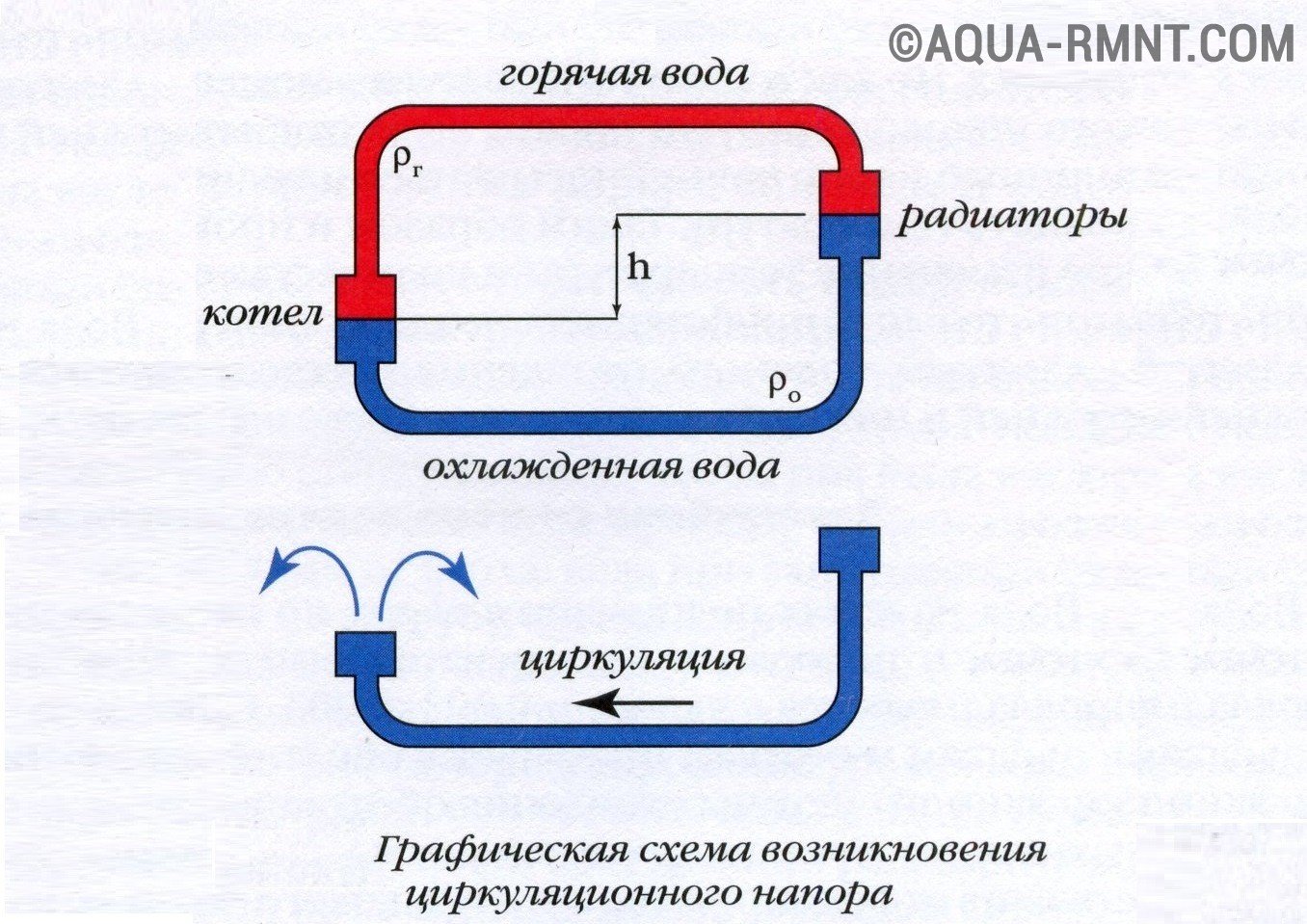
The circulation head in the heating system, in the first place, depends on the difference in the height of the boiler and the lower radiator. The greater this difference (h), the greater the pressure
Characterized by heating with natural circulation by a cyclic temperature change in the heat exchangers and in the boiler, which occurs along the central axis of the instruments. Hot water is at the top, the cold water is at the bottom. Under the influence of gravity, the cooled coolant moves down the tubes.
The circulation head is directly dependent on the height of the batteries. Its increase is facilitated by the angle of inclination of the supply line, directed towards the radiators, and the slope of the return, facing the boiler. This allows the heat carrier to more easily overcome the local resistance of the pipes.
When installing in a private home heating system with natural circulation, the boiler is installed at the lowest point so that all radiators are higher.
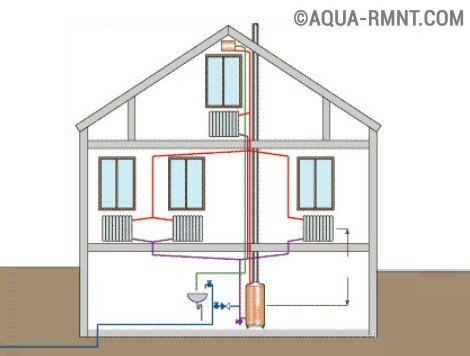
In the cottage, when installing a heating system with natural circulation, the boiler is installed at the lowest point. All heat exchangers (radiators) must be higher
For apartment houses, heating schemes with natural circulation are very rarely used, since when installed in an apartment the boiler is lowered into the "pit" - directly on the slab. The floor around it is sawed out, and the deepening and perimeter around it should be protected by fireproof materials.
Schemes of such heating systems
The scheme of the heating system, regardless of the way the coolant circulates, depends on several factors:
- the method of connecting radiators with feeder risers. Here one-pipe and two-pipe systems are distinguished;
- place of laying the main, supplying hot water. Choose between the bottom and top wiring;
- scheme of laying the main: a dead-end system or a passing movement of the coolant in the mains;
- the arrangement of risers, which can be either horizontal or vertical.
Single-pipe system: how to adjust the temperature?
Has only one version of the wiring layout - the top one. There is no reverse riser in it, so the coolant cooled in the batteries returns to the supply line. The movement of the liquid is provided by the difference in the temperature of the liquid in the lower and upper radiators.
To ensure the same temperature regime in rooms on different floors, the surface of the heating devices on the ground floor should be somewhat larger than on the second and subsequent. In the lower radiators comes a mixture of hot and cooled in the upper heat exchangers water.
In a single-tube system there can be two variants of motion: in the first one part goes to the radiator, the other - further along the riser to the lower instruments.
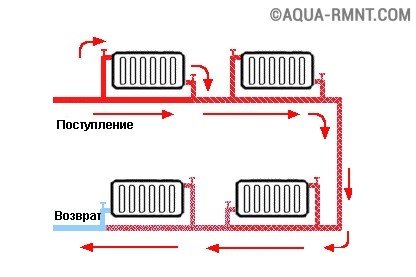
With parallel single-pipe wiring, heat exchangers on the upper floors receive hot water, and the lowest ones - already cooled. Therefore, the area of the latter should be increased to equalize the heating of all rooms
In the second case, the entire volume of water passes through each heat exchanger, starting from the uppermost. The main feature of such a wiring is that the radiator on the first and basement floors receive only chilled water.
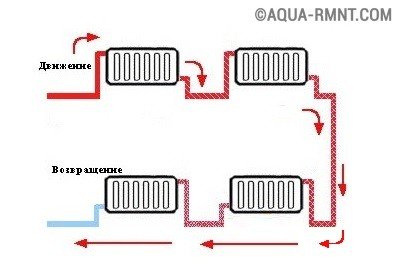
With a flow-through version of single-pipe wiring, you can not disable or limit the flow of coolant into a separate radiator. Overlapping one of them would lead to a halt in the circulation throughout the system
And if in the first case it is possible to regulate the temperature in the premises with the help of cranes, then in the second one they can not be used, since this will lead to a decrease in the supply of liquid to all subsequent heat exchangers. In addition, a complete shutdown of the faucet would mean stopping the circulation of water in the system.
When installing single-pipe system it is better to stop on the wiring, which makes it possible to adjust the water supply to each radiator. This will allow to regulate the temperature in individual rooms and, naturally, makes the heating system more flexible, and therefore more efficient.
Since single-pipe wiring can only be upper, its installation is only possible in buildings with an attic space. It is there that the supply pipeline should be located. The main disadvantage is that the start-up of heating is possible only throughout the building at once. Of course, there are advantages to the system, too. The main ones are simple installation and lower cost. In terms of aesthetics, the fewer pipes, the easier it is to hide them.
How should a two-pipe system be arranged?
This variant of the heating scheme assumes the presence of a supply and discharge line. In the upper part of the system, a hot heat carrier circulates, while in the lower part it is cooled.
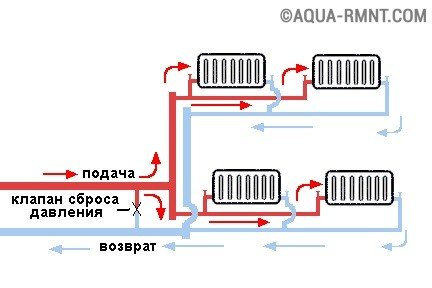
The two-pipe heating system is more flexible with regard to temperature control in individual rooms. However, it requires more materials than a single-tube
From the boiler goes the pipe, connected to the expansion tank. From the tank there is a pipe of the hot line of the circuit, which then connects to the wiring. Depending on the size of the tank and the volume of water in the system, the overflow pipe may leave the tank. Over it, excess water is drained into the sewer.
Pipes emanating from the bottom of the heat exchangers are combined in a return line. On it the cooled coolant again gets into the cauldron. The return must pass through the same premises as the supply pipeline.
Is there a horizontal or vertical riser in the wiring?
The heating system with a vertical riser is designed to connect radiators from different floors to it. Its advantage: lower risk of "zavozdushivaniya" of the system, a disadvantage - a higher cost.
When heat exchangers from one floor are connected to a supply pipe, this is a system with a horizontal riser. This option will cost homeowners in a smaller amount, but will have to solve the problem of the formation of air congestion. As a rule, it is enough to install air vent.
Pros and cons of the arrangement of heating of this type
As for the advantages of a heating system with natural water circulation, there are several:
- absence of complications during installation, start-up and operation;
- thermal stability of the system. Based on the gravitational circulation of the heat carrier, it ensures maximum heat transfer and maintains a microclimate in the rooms at a given level;
- economy (with proper insulation of the building);
- quiet work. No pump - no noise and no vibration;
- independence from power outages. Naturally, in the case when the installed boiler can work without electricity;
- long service life. With timely maintenance without major repairs, the system can operate for 35 years or more.
The main disadvantage of the gravitational heating system is the restrictions on the area of the building and the radius of the action. It is installed in houses, the area of which usually does not exceed 100 square meters. Due to the low circulation head, the system's operating radius is limited to thirty meters horizontally. An obligatory requirement is the presence of an attic space in the building in which the expansion tank will be installed.
A significant disadvantage is the slow warming up of the whole house. In a system with natural circulation it is necessary to insulate the pipes passing in unheated rooms, since there is a risk of freezing of water.
Usually there is not much material for such a wiring, but when the local resistance of the pipeline needs to be reduced, the costs increase due to the need for larger diameter pipes.



